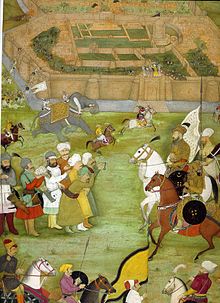- Mughal–Safavid War (1649–1653)
-
Mughal–Safavid War Date 1649–1653 Location Afghanistan Result Safavids recapture Kandahar Territorial
changesKandahar is captured by the Mughals by falls once again to the Safavids. Belligerents  Safavid Empire
Safavid Empire Mughal Empire
Mughal EmpireCommanders and leaders Abbas II of Persia
Mehrā Khan
Autar KhanShah Jahan
Aurangzeb
Dara Shikoh
Murad BakshStrength 65,000
12,000 Zamburak
80,000
Casualties and losses 5000 7000 The Mughal–Safavid War of 1649-1653 was fought between the Mughal and Safavid Empires in the territory of modern Afghanistan. The war started after a Persian army, while the Mughals were at war with the Janid Uzbeks, captured the fortress city of Kandahar and other strategic cities that controlled the region. The Mughals attempted to regain the city back but after the last attack on 1653 the city remained on Safavid hands.
Contents
Background
The Safavids held territorial claims over Kandahar ever since the reign of Shah Tahmasp. The overthrown Mughal Emperor Humayun, is known to have gained the support of Shah Tahmasp in return for his permission to allow the Safavids to capture Kandahar.
However conflicts would emerge in the region around Kandahar during the reign of the Mughal Emperor Jahangir, because most of the locals opposed Safavid rule and often served in the Mughal Army.
Origins
 A miniature painting from the Padshahnama, depicting the surrender of the Safavid garrison in the city of Kandahar to the Mughal Emperor Shah Jahan during the year 1638.
A miniature painting from the Padshahnama, depicting the surrender of the Safavid garrison in the city of Kandahar to the Mughal Emperor Shah Jahan during the year 1638.
Shah Jahan's reign was marked in the northwest by the continuous struggle against the Persians for Afghanistan. In 1639 the armies of Shah Safi of Persia captured Bamyan and it appeared that they would attack Kandahar next. Shah Jahan with the help of Kamran Khan and Malik Maghdood had marched on Kandahar and negotiated the surrender from the Persian commander, Ali Mardan Khan, in 1638. The Emperor expected the Persians to attempt to regain the city soon, so he ordered to speed the repairs of the walls while a large Mughal army in Kabul protected the country. When no Persian attack came, in 1646 the Emperor sent his son, Murad Baksh, to invade Uzbek-controlled Badakhshan. The next year Prince himself Aurangzeb routed an Uzbek force outside of Balkh and captured the city.[1] Tough victorious in the field the Mughals were unable to secure the conquered territories and Shah Jahan was forced to recall his armies from Badakhshan.
War
 The Mughal Emperor Shah Jahan receives Safavid ambassadors, negotiating peace and a viable settlement to the brief conflict.
The Mughal Emperor Shah Jahan receives Safavid ambassadors, negotiating peace and a viable settlement to the brief conflict.
Encouraged by the Mughal's reversals in Badakhshan,[2] in the summer of 1648 Shah Abbas marched from Isfahan with and army of 40,000 and after capturing Bost he laid siege to Kandahar and captured it after a brief siege on February 22 1649.[3] The Mughals attempted to retake the city in 1651 but the arrival of winter forced them to suspend the siege.[3]
Shah Jahan sent Aurangzeb with 50,000 soldiers to recapture it, but although he defeated the Safavids outside the city he was unable to take it.[4] His artillery train proved unable for the task.[5] Aurangzeb attempted to take the fortress city again in 1652. Abdul Aziz, Khan of Bukhara, had entered into an alliance with Shah Abbas and in May 1652, he dispatched 10,000 troops to Kabul in May to harass the Mughal supply lines.[6] Though not strong enough to lift the siege, the Uzbeks endangered a Mughal convoy of 2,000 who were escorting one and a half million silver coins to the besieger's army at Kandahar.[6] After two months of fighting Persian resistance[5] and the growing activities of the Uzbeks,[3] Aurangzeb was forced to abandon the campaign.
In 1653 Shah Jahan sent his favorite son, Prince Dara Shikoh, with a large army and two of the heaviest artillery pieces of the Empire,[4] but after a five month siege the Mughals couldn't manage to starve the city an the attempt to breach their walls by canon fire also failed.[4] The Mughals finally gave up all attempts to recover Kandahar.[5]
Notes
Sources
- Burton, Audrey (1997). The Bukharans:a dynastic, diplomatic, and commercial history, 1550-1702. Palgrave Macmillan. ISBN 0312173873, 9780312173876. http://books.google.com/books?id=6c1elcwgUzAC.
- Chandra, Satish (2005). Medieval India: from Sultanat to the Mughals. II. Har-Anand Publications. ISBN 8124110662, 9788124110669. http://books.google.co.ve/books?id=0Rm9MC4DDrcC.
- Kohn, George C. (2007). Dictionary of wars. Infobase Publishing. ISBN 0816065772, 9780816065776. http://books.google.com/books?id=OIzreCGlHxIC.
- "KANDAHAR iv. From The Mongol Invasion Through the Safavid Era". Encyclopædia Iranica. http://www.iranicaonline.org/articles/kandahar-from-the-mongol-invasion-through-the-safavid-era. Retrieved 13 October 2011.
- The Cambridge History of Iran, Volume 6. Cambridge University Press. 1986. ISBN 0521200946.
Categories:- 17th-century conflicts
- Battles involving the Mughal Empire
- Conflicts in 1649
- Conflicts in 1650
- Conflicts in 1651
- Conflicts in 1652
- Conflicts in 1653
- Safavid dynasty
- Wars involving Afghanistan
Wikimedia Foundation. 2010.
